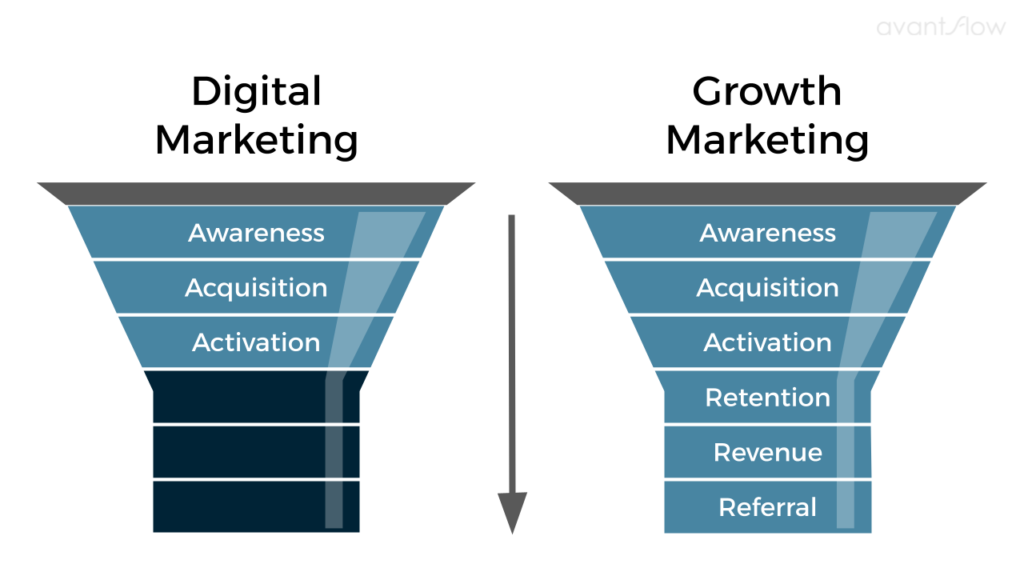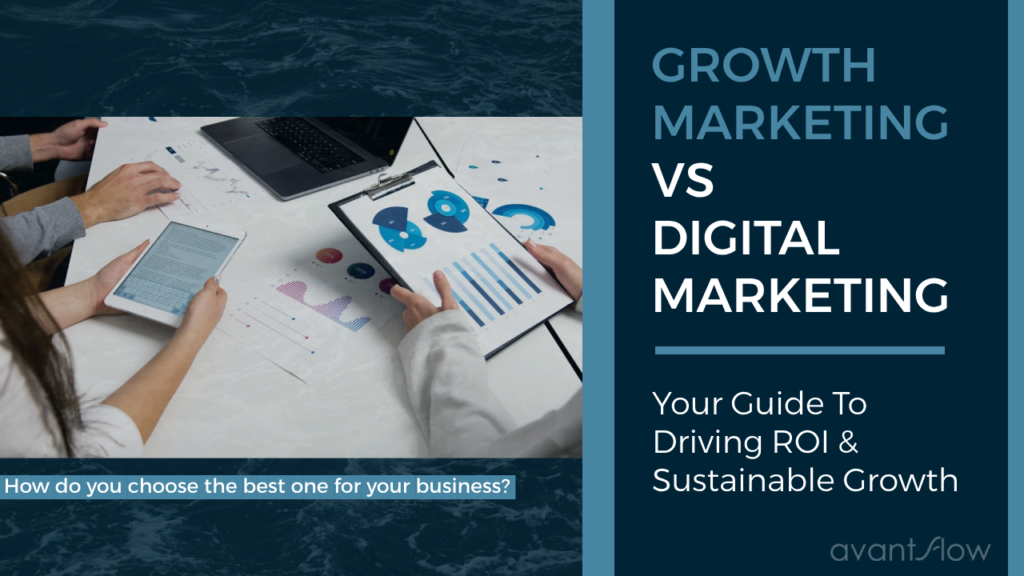Digital Marketing vs Growth Marketing: What’s the difference?
Quick Answer:
Digital marketing taps into established online channels like SEO, PPC, social media, email, and content to boost your brand and generate leads. In contrast, growth marketing takes a data-driven, full-funnel approach that uses continuous A/B testing and strategic experimentation to enhance customer acquisition, improve retention, and ultimately, boost ROI.
Keep reading if you’re ready to dive into a no-nonsense, practical guide that breaks down the essentials of growth marketing vs digital marketing.
Table of Contents
Introduction
In today’s fast-paced online market, deciding between digital marketing vs growth marketing is a key move for sustainable success.
Digital marketing lays the groundwork by building your online presence through proven methods like SEO, content marketing, and PPC. Growth marketing builds on that foundation with a systematic, data-driven approach that fine-tunes every step of the customer journey.
This guide explains the differences and benefits of growth marketing and digital marketing in clear, straightforward language that’s easy to understand—even if you’re not a marketing pro.
What is Digital Marketing?

Digital marketing is all about promoting your brand, products, or services online. And it’s the essential building block of an effective strategy. Key marketing channels include:
- SEO (Search Engine Optimization): Fine-tuning your website to rank higher in search results through smart keyword usage and on-page tweaks.
- PPC (Pay-Per-Click) Advertising: Running paid campaigns on search engines and social platforms to drive targeted traffic.
- Content Marketing: Creating engaging blogs, videos, and infographics to educate and entertain your audience.
- Social Media Marketing: Using platforms like Facebook, Instagram, and LinkedIn to connect with your audience and raise brand awareness.
- Email Marketing: Sending personalized emails that nurture leads and drive conversions.
These core digital marketing techniques help boost your visibility (online and offline) and attract potential customers.
What are some common digital marketing tactics?
Digital marketing is a mix of smart tactics working together to expand your online presence. A few common tactics include:
- Retargeting Ads: Reminding visitors who didn’t convert the first time to come back.
- Influencer Marketing: Collaborating with influencers and industry voices to extend your reach.
- Affiliate Marketing: Partnering with others who earn commissions for promoting your products or services.
- Video Marketing: Crafting compelling videos for platforms like YouTube, Instagram, or TikTok.
- Mobile Marketing: Optimizing campaigns for mobile devices to capture on-the-go users.
These strategies, when paired with core digital marketing techniques, create a powerful way to engage your target audience more effectively.
What are the metrics and KPIs for digital marketing?
To know if your efforts are paying off, digital marketing focuses on several key metrics:
- Impressions and Reach: How many people see your content.
- Click-Through Rate (CTR): The percentage of viewers clicking your ads.
- Conversion Rate: The number of visitors taking a desired action, like signing up or making a purchase.
- Cost Per Click (CPC) and Cost Per Acquisition (CPA): Indicators of your campaign’s cost efficiency.
- Engagement Rate: Gauging how well your content resonates through likes, comments, and shares.
- Bounce Rate: The percentage of visitors who leave after viewing just one page.
These KPIs form the backbone of measuring your digital marketing performance.
What is Growth Marketing?

Growth marketing builds on digital marketing by focusing on the entire customer journey—from first impressions to long-term loyalty. It’s about making smart, data-based decisions and continuously refining your strategy to foster sustainable growth. Key elements include:
- Full-Funnel Optimization: Using full-funnel growth marketing techniques for customer acquisition to guide prospects from the first touch to conversion and retention.
- Data-Driven Decisions: Constantly refining your approach using metrics like customer acquisition cost (CAC) and lifetime value (LTV).
- A/B Testing & Experimentation: Trying out different strategies to find what works best.
- Personalization & Segmentation: Tailoring your messaging to resonate with the specific needs of different customer groups.
- Rapid Iteration: Quickly adjusting strategies based on real-time feedback.
Growth marketing isn’t just about attracting new customers—it’s about keeping them engaged over the long haul.
What are some common growth marketing techniques?
Growth marketing uses a blend of proven tactics to drive measurable growth. Effective techniques include:
- A/B Testing: Comparing different versions of your website or emails to see which performs better.
- Cohort Analysis: Grouping customers by shared traits to understand behavior trends over time.
- Referral Programs: Encouraging happy customers to bring in new ones.
- Growth Loops: Creating self-reinforcing cycles where one customer leads to another.
- Behavioral Email Campaigns: Sending targeted messages based on user actions.
- Product Experimentation: Continuously tweaking your product based on customer feedback.
These techniques underline the benefits of growth marketing as a strategy for sustainable business success.
What are the metrics and KPIs for growth marketing?
Growth marketing takes a full-picture view of the customer journey and uses these metrics to gauge success:
- Customer Acquisition Cost (CAC): How much it costs to win a new customer.
- Lifetime Value (LTV): The total revenue a customer brings in over time.
- Churn Rate: The rate at which customers stop using your product.
- Activation Rate: The percentage of new users who take a key action that signals adoption.
- Retention Rate: How many customers stick around over time.
- Referral Rate: The percentage of new customers acquired through referrals.
- Engagement Metrics: Deep insights like session duration and repeat visits.
Tracking these metrics helps you continuously optimize your strategy and ensure growth at every stage of the funnel.
Growth Marketing vs Growth Hacking
While the terms “growth marketing” and “growth hacking” are often used interchangeably, they’re not the same.
Growth hacking is about quick wins and unconventional tactics for rapid growth, whereas growth marketing takes a broader, systematic approach to nurture long-term customer relationships. In short:
- Scope: Growth hacking is for immediate gains; growth marketing is for lasting growth.
- Methodology: Growth hackers lean on creative shortcuts, while growth marketers rely on structured, data-driven testing.
- Objective: Growth hacking delivers quick wins, but growth marketing builds enduring customer loyalty.
Growth Marketing vs Digital Marketing: Key Differences

Here’s a quick recap of the main differences:
Digital marketing is all about building brand awareness and capturing initial engagement. Growth marketing goes further by optimizing the entire customer journey for sustainable growth. These distinctions are crucial when deciding which strategy best suits your business.
Differences Between Digital Marketing and Growth Marketing: A Side-by-Side Comparison
This table outlines the key differences and benefits of growth marketing and digital marketing—use it like a cheat sheet:
| Aspect | Digital Marketing | Growth Marketing |
|---|---|---|
| Primary Focus | Building brand awareness and generating leads | Optimizing every stage for sustainable growth and ROI |
| Approach | Traditional tactics: SEO, PPC, content, and social media | Data-driven, iterative testing and analysis (A/B testing, analytics) |
| Key Metrics | Impressions, CTR, and basic conversion rates | CAC, LTV, retention, and overall ROI |
| Customer Lifecycle | Focuses mainly on the top of the funnel (awareness, engagement) | Optimizes every step from acquisition to retention and referral |
| Budget & Flexibility | Fixed budgets with set tactics | Agile budgeting with continuous adjustments |
ROI Comparison: Growth Marketing vs Digital Marketing

Digital marketing often delivers quick wins with metrics like impressions, clicks, and conversions. However, it might not capture the full long-term value of your customers.
Growth marketing, on the other hand, optimizes ROI at every stage of the customer journey—from acquisition through retention.
Since growth marketing and digital marketing serve two different purposes (boosting ROI vs increasing lead generation/brand awareness), combining both approaches can often deliver the best overall returns.
[ Want to launch a campaign that combines digital marketing and growth marketing? We can help ]
What are the benefits of Digital Marketing?
Digital marketing offers several key advantages that are vital to a robust online strategy. A few benefits of digital marketing include:
- Broad Reach: Connect with a diverse and extensive audience.
- Cost-Effectiveness: Tactics like SEO and content marketing deliver strong returns even on a modest budget.
- Brand Visibility: A consistent online presence builds trust and recognition.
- Measurable Results: Detailed analytics let you track success through key metrics like CTR and conversion rates.
- Flexibility: Campaigns can be quickly adjusted to stay in step with market trends.
What are the benefits of Growth Marketing?
Growth marketing is all about achieving long-term, sustainable success by optimizing every phase of the customer journey. Its benefits include:
- Full-Funnel Optimization: Enhances every step—from first impressions to long-term loyalty.
- Lower Customer Acquisition Costs: Continuous testing drives down the cost of gaining new customers.
- Higher Customer Lifetime Value: A focus on long-term relationships boosts overall revenue per customer.
- Agility and Innovation: Quick experiments keep your strategy fresh and effective.
- Customer-Centricity: Tailored, data-driven approaches make every customer feel valued.
These benefits showcase why growth marketing is increasingly vital in today’s competitive market.
When to Choose Digital Marketing
Digital Marketing is best for:
- New Brand Establishment: Ideal for building recognition and getting your name out there.
- Predictable Markets: Works well when customer behavior is stable.
- Cost-Conscious Campaigns: Perfect for straightforward, measurable approaches.
- Long-Term Relationship Building: Great for slowly nurturing and expanding your customer base.
Common Use Cases:
- B2B Marketing: Establishing thought leadership and generating reliable leads.
- E-Commerce: Driving organic traffic through SEO and engaging content.
- Local Businesses: Reaching community audiences with targeted local SEO and social media ads.
When to Choose Growth Marketing
Growth Marketing is best for:
- Rapid Scaling Startups: When speed and agility are essential.
- Highly Competitive Markets: Where continuous testing gives you a competitive edge.
- Product-Led Companies: When your product naturally drives referrals and loyalty.
- Data-Intensive Organizations: For businesses that can fully harness advanced analytics.
Common Use Cases:
- SaaS Companies: Optimizing the full funnel from trial sign-ups to subscriptions.
- Mobile Apps: Enhancing in-app engagement and conversion through ongoing testing.
- Subscription Models: Reducing churn and boosting customer lifetime value.
Take the Leap – Transform your strategy with expert growth marketing services now!
Digital Marketing vs Growth Marketing: Blending Both for Optimal Results

The best marketing strategies often mix the broad reach of digital marketing with the precision of growth marketing. Merging these approaches creates a well-rounded strategy that fine-tunes every stage of your customer journey.
When integrating digital and growth marketing for scalability, follow these steps:
- Lay a Solid Digital Foundation:
Use proven tactics like SEO, Content, PPC, and social media to build your online presence. - Implement Growth Marketing Techniques:
Apply A/B testing and deep analytics to refine your customer journey once traffic starts flowing. - Measure & Iterate:
Keep track of both digital and growth metrics (like impressions, CAC, and LTV) and adjust as needed. - Align Teams Across Functions:
Ensure marketing, sales, and product teams work together for a seamless customer experience.
This hybrid approach leverages traditional methods with full-funnel growth marketing techniques to deliver impressive results—from boosting revenue to maximizing customer lifetime value.
[Ready to boost your performance? Speak with a growth marketing expert]
Real-World Examples & Case Studies
Case Study 1: SaaS Company Scaling Rapidly
A local SaaS startup built its brand with digital marketing and then ramped up growth marketing using A/B testing and customer segmentation. This integrated approach reduced their CAC by 20% and improved customer retention by 30%. These real-world examples clearly illustrate the power of a well-rounded strategy.
Case Study 2: Local Retailer’s Digital Transformation
A local retailer combined traditional digital tactics (like local SEO and social media ads) with growth marketing strategies—such as personalized email campaigns and iterative landing page tweaks. The result? A 40% boost in both foot traffic and online sales, proving that merging these approaches works.
Case Study 3: Family-Owned Business Goes National
A local service business built its brand and reputation with traditional grassroots marketing. But the real magic happened when they took their marketing efforts to the internet, initially growing their audience with blogging, SEO, and social media. They later scaled their efforts with growth marketing and achieved a 764% increase to organic traffic, a 35% boost to annual revenue, and a 14x increase in conversions. You can read more about this case study here.
Growth Marketing Expert Recommendations & Best Practices
- Define Clear Objectives:
Set SMART goals—whether you’re aiming to boost brand awareness, lower CAC, or increase LTV—to steer your strategy. - Invest in Robust Analytics:
Tools like Google Analytics, HubSpot, and Mixpanel help you track your results accurately. - Embrace a Culture of Experimentation:
Keep testing new ideas and adjust your tactics based on real data. - Align Cross-Functional Teams:
Encourage tight collaboration between marketing, sales, and product teams. - Leverage Customer Feedback:
Listen to what your customers say and refine your strategy accordingly.
[Need help with growth marketing? Get your free consultation today]
Benefits of Working with a Growth Marketing Agency

If you’re pressed for time or lack in-house expertise, partnering with a dedicated growth marketing agency is a smart move. Here’s why:
- Access to Expertise:
Agencies bring deep knowledge in both digital and growth marketing, helping you make the most of every opportunity. - Cost Efficiency:
Rather than building an in-house team, a growth marketing company offers a cost-effective solution with proven results. - Data-Driven Strategies:
Agencies continuously optimize your campaigns with A/B testing and real-time insights, ensuring you maximize ROI. - Scalability and Flexibility:
They can quickly adapt to market shifts and integrate digital and growth tactics for sustained scalability. - Holistic Campaign Management:
With a comprehensive view of your customer journey, a growth marketing agency unifies the benefits of digital marketing with innovative growth strategies for long-term success.
[Ready to grow, but don’t know where to start? Contact us for your free consultation ]
Conclusion
Choosing between digital marketing and growth marketing isn’t about picking one over the other. It’s about leveraging the strengths of both. Digital marketing builds your online presence, while growth marketing fine-tunes your strategy with data-driven insights that secure long-term customer loyalty. Together, they create a powerful strategy for maximizing ROI and driving sustainable growth.
Embrace the synergy of growth marketing and digital marketing to position your business for lasting success.

Chris is a seasoned digital strategist and growth marketing expert with over a decade of experience guiding businesses through data-driven marketing transformations. With a passion for continuous testing and a commitment to customer-centric strategies, Chris helps companies build a robust online presence and achieve measurable, scalable growth.
